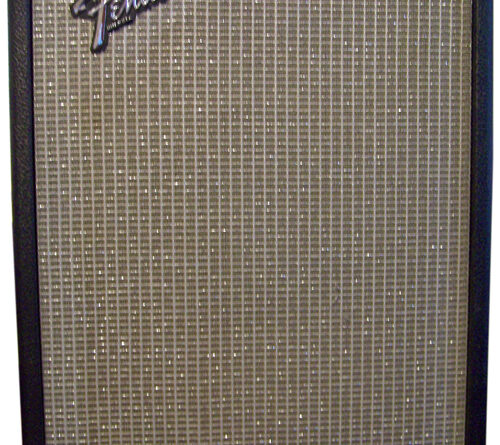Fender Bassman 20
Model/Circuit Number:
Years of Production: 1982 – 1983
Era: Rivera
Configuration: Combo
Controls: Black forward facing w/ white labels
Knobs: Black skirted w/ chrome center, numbered 1 – 10
Schematics
Faceplate:
- Front: In, Vol, Treb, Mid, Bass – Power Sw, Pilot Lamp
- Rear:
Cabinet:
- Dimensions: 24 3/4″ x 17″ x 11 7/8″
- Hardware: Small Chassis Straps 3 5/8″
- Handle: Black strap handle with Chrome ends
- Feet: Chrome Glides
- Corners: Chrome Corners with Lip
Tolex/Tweed:
Grill Cloth:
Logo: Grill mounted, raised, chrome & black, script
Weight:
Speaker:
- Size: 1 x 15 Fender (Eminence Made)
- Impedance: 8 ohms
- Model: (For more info, check out the Jensen Replacement Speakers)
Effects:
Watts: 18 watts
Tubes:
- Pre amp: 2 x 7025
- Power: 2 6V6
- Bias: Fixed
- Rectifier: Solid State
Comments:
Less than 500 of the amps made from 1982-1983


I’ve been researching the Rivera-era range of amps since 2004 and it looks like they made around three thousand Bassman 20s. The confusion arises when people misread the tables at the back of the excellent Teagle and Sprung book – it’s easy to mistake the ‘original price in dollars’ column for ‘how many made’. My website (info only, non-commercial)
http://www.stratopastor.org.uk/strato/amps/twoseriesfenders/twoseriesfenders.html
Thanks Andrew.. Great site!
The typo: 1983 not 1993
Note: the Riveria redesigned Bassman 20 was a solid state amp with yet a 15″ speaker. It appeared in 1993. Probably was produced in numbers exceeding thousands. But this should not be confused with the short lived previous version which was a 18 watt tube driven hybrid 1981-’82. Which Fender produced in numbers of roughly 500. The cabinets look quite similar. However the Riveria solid state models faceplate is stenciled with the word ‘compact’ underneath the Bassman 20 lettering.
The typo: 1983 not 1993
18 watts??
More like 70 watts.
70 watts? no way not with just 2 6v6s in the power section.
Faceplate has the following info:
120v 60Hz ~
0.7 A 70 watts
amps are discussed in power section output dissipation. 70 watts is the draw at the wall power.
any dual 6v6 amps will dissipate 12 to 20 watts depending on the circuit.
Hence the “20” in the name.
I was in error. Thanks for the info! Sure sounds bigger than a 20-watt amp.
Hey- My Bassman 20 was featured in Premier Guitar’s “Trash or Treasure” column(Feb/2014) & Zach’s (who works for “Guitar Bluebook”) research found that under 600 of these were made.@ no time did these sell for $600. The simple circuitry in these makes a great amp for recording bass & guitar. I paid $125 for mine in 1985. -Thanks-JB
James, no disrespect to Zach but I believe he’s accidentally passing on an internet myth. However if he’s actually done research I’d be pleased to exchange info with him! best wishes…
actually I’ve just looked back at Zach’s article and he says “I’ve seen reports of around 500 or so being produced.” No mention of research, so I’ll stick with my findings at least for now. Around 2500 made.
Andrew — Was just looking again @ our conversation & while you disagree w/#’s this rarity(or not) has never had a correlation to worth — as Zach clearly states. It’s worth more than the $125 I paid for it 30 years ago it’s relative low worth has never been something anyone disputed.It is a great guitar/recording/studio amp that I use w/an SRC Crossover — JB
Just out of curiosity what research have you done to come up with the 2500/3000 number? I’m not disputing your claim at all and actually think it’s more likely than 500 to 600 but you didn’t site any sources or provide your research methods for coming up with that data either unless i missed it
Anyone know what the value of these amps are now?
Tom — I paid $125 for mine in 1985 & it’s gone up some due to it’s worth as a studio amp – low watts & simple circuitry & it’s use as a guitar or bass amp. The highest $’s I’ve seen were $550 — I haven’t seen 1 for sale in a long time tho — Thanks –JB
James, I thoroughly agree with Zach and yourself concerning the amp’s actual worth. I would be pleased to own one no matter how many were made.
I traded a 2014 epiphone mini 335 style for mine, extremely happy with the trade.
The trouble with the Bassman 20 is the transformers. The output transformer is from a Princeton amp and not up for the task of reproducing bass, in fact the amp purposeful rolls off bottom end to stop early distortion.
It’s not going to put out as much low end as a ported 15 with a 100 watt head. But it puts out plenty for recording. You don’t need to move much air to get all the bass you need for recording situations. Most engineers roll the bass off pretty substantially also compared to what you hear from an amp. It won’t ever sound like an Ampeg or Mesa, but it’s not supposed to.
The trouble with the Bassman 20 is that it uses a Princeton output transformer, the power transformer is Champ sized. The output transformer is way too small for a Bass amp. You would do better to put a Deluxe Reverb output transformer or something with a bigger core. Once that is done the circuit has to be modified to allow the bass response to pass through the amp. I have removed this stuff only to find out the amp distorted very easily.
With a better transformer set and a little modification it would be a better sounding bass amp.
I own three. Of the tube version. I might have a problem…………..
wanna sell one?